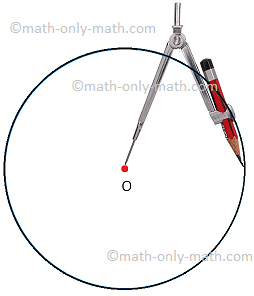Problems on Hyperbola
We will learn how to solve different types of problems on hyperbola.
1. Find the position of the point (6, - 5) relative to the hyperbola \(\frac{x^{2}}{9}\) - \(\frac{y^{2}}{25}\) = 1.
Solution:
The given equation is of the hyperbola is \(\frac{x^{2}}{9}\) - \(\frac{y^{2}}{25}\) = 1
We know that the point P (x\(_{1}\), y\(_{1}\)) lies outside, on or inside the hyperbola \(\frac{x^{2}}{a^{2}}\) - \(\frac{y^{2}}{b^{2}}\) = 1 according as \(\frac{x_{1}^{2}}{a^{2}}\) - \(\frac{y_{1}^{2}}{b^{2}}\) - 1 < 0, = or > 0.
According to the given problem,
\(\frac{x_{1}^{2}}{a^{2}}\) - \(\frac{y_{1}^{2}}{b^{2}}\) – 1
= \(\frac{6^{2}}{9}\) - \(\frac{(-5)^{2}}{25}\) - 1
= \(\frac{26}{9}\) - \(\frac{25}{25}\) - 1
= 4 - 1 - 1
= 2 > 0.
Therefore, the point (6, - 5) lies inside the hyperbola \(\frac{x^{2}}{9}\) - \(\frac{y^{2}}{25}\) = 1
2. The co-ordinates of the vertices of a hyperbola are (9, 2) and (1, 2) and the distance between its two foci is 10. Find its equation and also the length of its latus rectum.
Solution:
According to the problem the ordinates of the vertices of the required hyperbola are equal. Therefore, the transverse axis of the hyperbola is parallel to axis and conjugate axis is parallel to y-axis.
The mid-point of the vertices (\(\frac{9 + 1}{2}\), \(\frac{2 + 2}{2}\)) = (5, 2)
The mid-point of the vertices is the centre of the required hyperbola.
Therefore, the centre of the required hyperbola is (5, 2)
Let the equation of the required hyperbola be \(\frac{(x - α)^{2}}{a^{2}}\) - \(\frac{(y - β)^{2}}{b^{2}}\) = 1
Now, the length its transverse axis = the distance between the two vertices i.e., the distance between the points (9, 2) and (1, 2) = 8
i.e., 2a = 8
⇒ a = 4.
Again, the distance between the two foci = 2ae = 10
⇒ ae = 5.
Now, b\(^{2}\) = a\(^{2}\)(e\(^{2}\) - 1)
= a\(^{2}\)e\(^{2}\) - a\(^{2}\)
= 5\(^{2}\) - 4\(^{2}\)
= 25 - 16
= 9
Now form the equation \(\frac{(x - α)^{2}}{a^{2}}\) - \(\frac{(y - β)^{2}}{b^{2}}\) = 1, we get,
⇒ \(\frac{(x - 5)^{2}}{16}\) - \(\frac{(y - β)^{2}}{9}\) = 1
⇒ 9x\(^{2}\) - 16y\(^{2}\) - 90x + 64y + 17 = 0.
Therefore, the equation of the required hyperbola is
The length of the latus rectum of the hyperbola = 2 ∙ \(\frac{b^{2}}{a}\) = 2 ∙ \(\frac{9}{4}\) = \(\frac{9}{2}\) units.More problems on hyperbola:
3. Find the equation of the hyperbola whose co-ordinates of the foci of a hyperbola are (± 6, 0) and its latus rectum is of 10 units.
Solution:
Let the equation of the required hyperbola be,
\(\frac{x^{2}}{a^{2}}\) - \(\frac{y^{2}}{b^{2}}\) = 1
The co-ordinates of the foci of the hyperbola \(\frac{x^{2}}{a^{2}}\) - \(\frac{y^{2}}{b^{2}}\) = 1 are (± ae, 0) and the lenght of its latus rectum is 2 ∙ \(\frac{b^{2}}{a}\).
According to the problem,
ae = 6 ……………….. (i) and
2 ∙ \(\frac{b^{2}}{a}\) = 10 ……………….. (ii)
Now form the above equation (ii) we get,
2b\(^{2}\) = 10a
⇒ a\(^{2}\)(e\(^{2}\) - 1) = 5a , [Since, we know that, b\(^{2}\) = a\(^{2}\)(e\(^{2}\) - 1)]
⇒ a\(^{2}\)e\(^{2}\) - a\(^{2}\) - 5a = 0
⇒ 6\(^{2}\) - a\(^{2}\)- 5a = 0 (Since, we know that, ae = 6)
⇒ a\(^{2}\) + 5a - 36 = 0
⇒ a\(^{2}\) + 9a - 4a - 36 = 0
⇒ a(a + 9) - 4(a + 9) = 0
⇒ (a + 9)(a - 4) = 0
⇒ (a + 9) = 0 or (a - 4) = 0
⇒ a = - 9 or, a = 4
⇒ a = -9 is not possible.
Therefore, a = 4
Therefore, b\(^{2}\) = a\(^{2}\)(e\(^{2}\) - 1)
= (ae)\(^{2}\) - a\(^{2}\)
= 6\(^{2}\) - 4\(^{2}\)
= 36 - 16
= 20
Therefore, the required equation of the hyperbola is
\(\frac{x^{2}}{a^{2}}\) - \(\frac{y^{2}}{b^{2}}\) = 1
⇒ \(\frac{x^{2}}{16}\) - \(\frac{y^{2}}{20}\) = 1
⇒ (5x)\(^{2}\) - 4y\(^{2}\) = 80.
● The Hyperbola
- Definition of Hyperbola
- Standard Equation of an Hyperbola
- Vertex of the Hyperbola
- Centre of the Hyperbola
- Transverse and Conjugate Axis of the Hyperbola
- Two Foci and Two Directrices of the Hyperbola
- Latus Rectum of the Hyperbola
- Position of a Point with Respect to the Hyperbola
- Conjugate Hyperbola
- Rectangular Hyperbola
- Parametric Equation of the Hyperbola
- Hyperbola Formulae
- Problems on Hyperbola
From Problems on Hyperbola to HOME PAGE
Didn't find what you were looking for? Or want to know more information about Math Only Math. Use this Google Search to find what you need.
Recent Articles
-
Dividing 3-Digit by 1-Digit Number | Long Division |Worksheet Answer
Apr 24, 24 03:46 PM
Dividing 3-Digit by 1-Digit Numbers are discussed here step-by-step. How to divide 3-digit numbers by single-digit numbers? Let us follow the examples to learn to divide 3-digit number by one-digit nu… -
Symmetrical Shapes | One, Two, Three, Four & Many-line Symmetry
Apr 24, 24 03:45 PM
Symmetrical shapes are discussed here in this topic. Any object or shape which can be cut in two equal halves in such a way that both the parts are exactly the same is called symmetrical. The line whi… -
Mental Math on Geometrical Shapes | Geometry Worksheets| Answer
Apr 24, 24 03:35 PM
In mental math on geometrical shapes we will solve different type of problems on simple closed curves, polygons, basic geometrical concepts, perpendicular lines, parallel lines, circle, terms relates… -
Circle Math | Terms Related to the Circle | Symbol of Circle O | Math
Apr 24, 24 02:57 PM
In circle math the terms related to the circle are discussed here. A circle is such a closed curve whose every point is equidistant from a fixed point called its centre. The symbol of circle is O. We… -
Fundamental Geometrical Concepts | Point | Line | Properties of Lines
Apr 24, 24 12:38 PM
The fundamental geometrical concepts depend on three basic concepts — point, line and plane. The terms cannot be precisely defined. However, the meanings of these terms are explained through examples.




